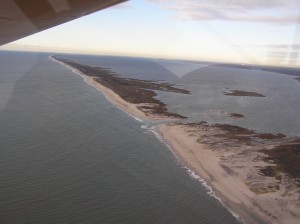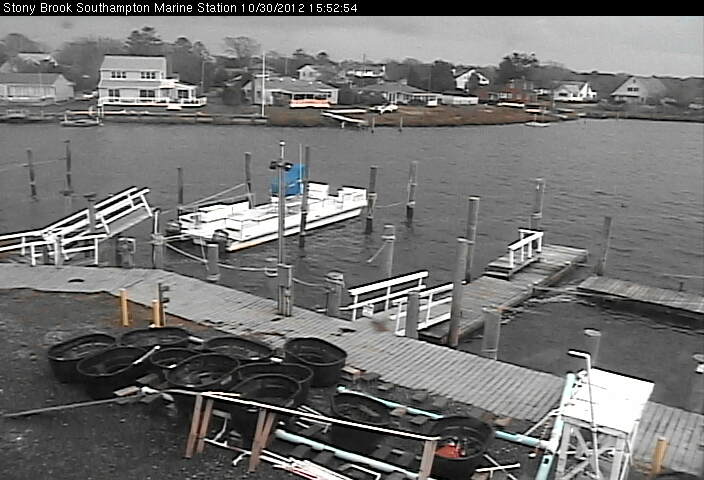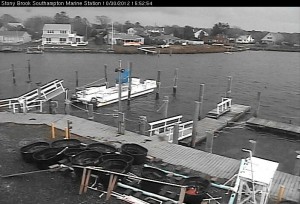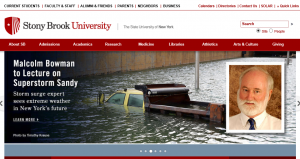SoMAS Reports
SoMAS News Report on Hurricane Sandy from November 5, 2012
From New York Sea Grant :
New York Sea Grant’s coverage of Hurricane Sandy
New York Sea Grant’s archive of Superstorm Sandy coverage
From the Storm Surge Research Group | SSRG Sandy Publications
Malcolm Bowman’s article Superstorm Sandy – How did it happen and are we prepared for the future? – February 1, 2013
Superstorm Sandy Windspeed Animation (YouTube) | MP4 Created by Hamish Bowman
Storm Surge Animation (GIF) : Region | New York Harbor Created by Hamish Bowman
Storm Surge Barriers to Protect New York City: Against the Deluge (paperback) by Doug Hill and Malcolm Bowman
From the Great South Bay Ecosystem Project

The breach at Old Inlet on Fire Island (photo by Charlie Flagg)
Images from a previous breach in 1980 are available here
Charlie Flagg and Pilot Rich Giannotti fly over Fire Island Breaches (PDF)
Charlie Flagg gave a power point presentation on December 1, 2012 at Bellport’s community center that shows how the dynamics of the Great South Bay and the ocean resulted in the formation of the breach and how the breach has affected the tides, wind driven storm surge and the salinity of the eastern end of the Bay. (PPT)
Charlie Flagg’s December 14, 2012 report on the new inlet through November is available here. (PDF)
Charlie Flagg returns to the breach at Old Inlet on January 6, 2013 (PDF)
The Impact on Great South Bay of the Breach at Old Inlet on January 14, 2013 (PDF)
The Impact on Great South Bay of the Breach at Old Inlet January 31, 2013 (PDF)
The Impact on Great South Bay of the Breach at Old Inlet February 27, 2013 (PDF)
The Impact on Great South Bay of the Breach at Old Inlet March 10, 2013 (PDF)
The Impact on Great South Bay of the Breach at Old Inlet June 28, 2013 (PDF)
Old Inlet Flyover Mosaics and reports available on Dr. Flagg’s Great South Bay website.
The Complete set of Old Inlet Flyover Mosaics are also available.
Video
Storm Surge Research Group Superstorm Sandy Windspeed Animation Created by Hamish Bowman
Islands Made of Sand – Justin Fehntrich A short documentary film made by students from Stony Brook University examining the long term effects of Hurricane Sandy, the new Fire Island Inlet and sea level rise.
Fallen Tree near Challenger Hall at SoMAS
Charlie Flagg and Pilot Rich Giannotti fly over Fire Island Breaches
Video 1 | Video 2 | Video 3 | Video 4
Charlie Flagg and Pilot Rich Giannotti revisit the Fire Island Breaches Video
Protection from Future Storms
Metro New York
Malcolm Bowman has suggestions for protecting Metro New York
- Metro New York is at serious risk from extreme weather events and it will get worse in the decades ahead;
- The city’s current doctrine of “resilience” is necessary but not sufficient to protect the city against future catastrophes;
- What is needed for long term protection (up to 150 years) is the construction of storm surge barriers augmented by enhanced sand dunes along the ocean shorelines (up to 30′ high and several hundred yards wide), similar to those already in operation in St Petersburg, Russia, and the Netherlands;
- To make the project economically and politically feasible, an Outer Harbor Gateway would need to be a multipurpose system incorporating a 6-lane interstate toll road-bypass from northern NJ to Long Island/JFK airport, a light rail connection between Newark and JFK airports, as well as storm surge protection;
- What is now needed is a comprehensive study by the US Army Corps of Engineers, detailing oceanographic, meteorological, geological and engineering aspects, plus an investigation of suitable locations, the effects on ocean circulation and flushing, ecology, fisheries, transportation, legal aspects, social justice issues, and economics;
- Eventually rising sea levels will submerge New York City as we know it; but systems of seawalls, levees, barriers, pumps and enhanced dunes will extend the protection of the City to perhaps 200-250 years from now;
- We can learn much from the European experience – we have the advantage of being 75-100 years behind Amsterdam and Rotterdam’s situation of being located 6′-12′ below sea level – so we can learn.
Long Island
In his February 1, 2013 Newsday OpEd , Larry Swanson reminds us to “remember Long Island’s lagoons in future storm planning”
In his March 1, 2013 Newsday Letter, Chris Gobler recommends that we “keep inlet open for Bay health”









